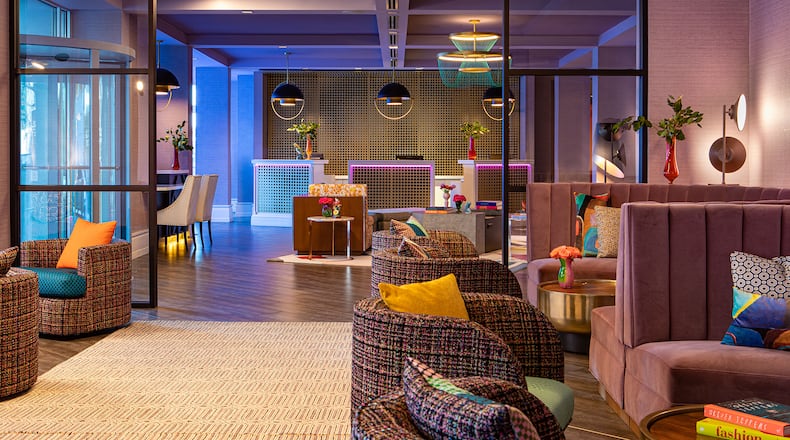As more people eat out at chef-driven restaurants and stay in boutique hotels, those spaces have stepped up their design game. Pity the sad, beige hotel lobbies and restaurants where design is an afterthought in the age of Pinterest, HGTV and Instagram.
“There’s almost nobody on this planet who’s going to say beige is their favorite color,” Andrew Alford, an interior designer for hotels including Buckhead’s eclectic, design-focused Hotel Colee, said with a laugh.
To attract the sophisticated traveler, interior designers are creating lobbies filled with local art, colorful furniture and cheeky collections like the vintage porcelain bird statues that Alford included in Hotel Colee’s lobby.
The more bespoke the better.
And just as these public spaces are striving for more personality, more color and a more distinct point of view, some homeowners are doing the same: They’re trying to figure out how to channel a sense of fun and celebration back home.
For interior designers, this means is that clients are increasingly asking for elevated design touches in their homes.
Tara Dennis, an interior designer, the co-owner of the Archie Bolden design firm and a resident of the Old Fourth Ward, has seen the hospitality designs that her firm creates for hotels and restaurants spilling over into her residential design projects. Those restaurants include Delbar, Bibi and Brash Coffee Roasters. Dennis is also working on an — as yet unnamed — new 10,000-square-foot Mideast-meets-barbecue concept from Delbar owner Fares Kargar in the West Midtown Star Metals district.
Credit: Katie Bricker
Credit: Katie Bricker
Dennis said that the buzziness of DJs, mixologists and open kitchens at contemporary restaurants have brought more performative energy and excitement to “front of house.”
“It’s very much taking a lot of the services that people used to hide away and celebrating them,” Dennis said.
Credit: Katie Bricker
Credit: Katie Bricker
Many of her clients now want to create a similar “night out” experience at home with cocktail bars set up near kitchens and maybe even a quirky home-sound system like a record player with vintage speakers or even a drum set placed center stage.
Dennis said she also advises clients to incorporate more practical aspects of hospitality design into their homes.
Because they design for well-trafficked settings that need to be impervious to wear and tear, a lesson she said that homeowners can take from hospitality designers is investing in materials that are durable. These include faux leathers, velvet upholstery, tightly woven fabrics, luxury vinyl flooring and quartz or porcelain slab countertops — all materials that stand up to children, pets and spilled drinks.
Credit: Katie Bricker
Credit: Katie Bricker
There are some easy ways for people to bring hospitality-focused innovations into their homes, said Alford, who is based in Portland, Oregon. He recommends “taking note of the things you love about favorite hotel experiences. And then just ask yourself: ‘How can I do this?’”
Take photos of items you love in a favorite hotel — for him, it’s the Ludlow on New York City’s Lower East Side — and then do a reverse Google image search to source them. You can also follow the practice of hotel designers to create a cohesive look: make a mood board of favorite furniture, accessories, wallpaper and artwork to map out your own look.
Alford’s design signature is assertive color. He said that really leaning into the colors you love and making bold design statements are keys to bringing personality and style to your space.
One of the Hotel Colee’s most Instagrammable places is its lobby where velvet couches in a dusty lavender are placed against the same shade of a durable vinyl wallcovering that resembles high-end grasscloth.
“I think that would be something really interesting for somebody to explore residentially,” he said.
For those who need to take some time before they go full-on rainbow, Alford recommends directing that creative energy to the powder room, where you can play with outrageous wallpaper and statement lighting.
“I’m a big proponent of going crazy in there,” he said.
On the other end of the color spectrum, Alford suggests mimicking the quiet luxury of the hotel experience by replicating the downy vibe of a plush bed.
“Everybody loves checking into a hotel and dropping into that white, fluffy bed,” he said. “Give yourself a clean, white bed.”
Some of the insider tips that Alford offers for bringing character and hotel style to your space is shopping for original art on Etsy. He loves to incorporate contemporary photography on a budget by going to open-source photo archives like Creative Commons and then printing and framing favorite images for instant wall art.
Both designers recommend thinking about your home in the same way they think about hospitality spaces: consider flow, create a welcoming experience in your “lobby” — in other words, your living room — and arrange seating to be more social.
“When we’re looking at an interior for hospitality, you have to think about everything from top to bottom,” Dennis said. “How does it look? How does it feel? How does it smell? How do you touch it? How do you interact with it? What is that journey through the space?”
Alford noted that, as in a hotel or restaurant, the focus should be on guests.
“When people come over, when I host family and friends,” he said, “I want them to feel like they’ve had a special experience by being in my space.”
Felicia Feaster is a longtime lifestyle and design editor who spent 11 years covering gardening, interior design, trends and wellness for HGTV.com. Felicia is a contributor to MarthaStewart.com and has been interviewed as a design expert by The New York Times, Forbes and the Associated Press.
About the Author
Keep Reading
The Latest
Featured





